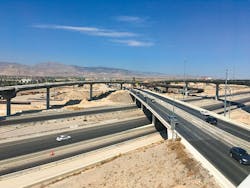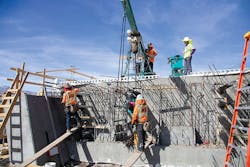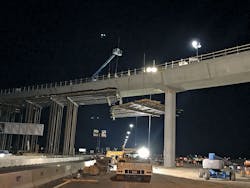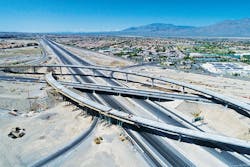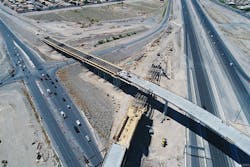Nevada’s second longest bridge takes center stage in Northwest Las Vegas
The Las Vegas Strip is world-famous for its lavish eye-catching productions; however, another unlikely superstar is commanding the spotlight a few miles away in the northwest valley.
It is the Nevada Department of Transportation’s (NDOT) half-mile-long interchange bridge known simply as the Northwest Connector linking together northbound U.S. Highway 95 with the westbound 215 Beltway.
At 2,635 ft long—the equivalent of seven football fields laid end-to-end—the Northwest Connector is the state’s second longest bridge. (Incidentally, Nevada’s longest bridge also resides in Las Vegas: the 50-year-old 1.6-mile-long I-515 viaduct between I-15 and Eastern Avenue). The off-Strip debut of the supersized Northwest Connector occurred at high noon on September 28, 2020, after years of planning, design, and construction.
“It’s not every day that you get a chance to design something this big. It really gives us a chance to showcase our abilities,” said NDOT lead designer Michael Taylor. “We start by evaluating several criteria including cost, constructability, site characteristics, and the ability to maintain traffic, among other things.”
Ultimately, the design team opted for a cast-in-place post-tensioned box girder structure, with a total width of 39 ft to accommodate two travel lanes for north-to-west traffic. Concrete was selected over steel plate girders due to cost, geometric suitability, and aesthetics.
“The concrete option has a slimmer, more sleek profile with soffits that won’t leave the girders exposed from underneath,” Taylor said.
The 75-ft-tall Northwest Connector is comprised of 13 spans in four frames, with the longest distance between frames measuring 240 ft or roughly the wingspan of a Boeing 747 jumbo jet. It is reinforced with 3 million lb of steel, which is enough iron to build 45 Sherman tanks, as well as 19,000 kips of longitudinal cable post-tensioning with transverse post-tensioning in the pier caps for reduced rebar congestion and improved durability. The substructure consists of oblong columns, measuring 6 ft by 8.5 ft, and varying in height from 25 ft to 61 ft. It rests atop a reinforced substructure of 10-ft-diameter drilled shafts, up to 80 ft in length. The choice of a cast-in-place post-tensioned concrete superstructure allowed the engineers to develop a bridge layout with longer span lengths than other considered superstructure types, resulting in fewer columns and drilled shafts.
Yet the mammoth-sized bridge still required over 1,800 lineal ft of falsework—the length of the Empire State Building laid on its side—necessitating the use of massive hydraulic mobile cranes by general contractor Las Vegas Paving Corp. And the falsework was erected over the freeway with minimal overnight closures, necessitating intense planning and coordination with construction team members, as well as neighboring businesses, residences, first responders, and other stakeholders. That also subsequently meant developing a multitiered public outreach program entailing a combination of media releases, press interviews, and viral videos, as well as maps, infographics, email notices, and social media posts.
Meanwhile, bridge construction required 14,300 cubic yd of concrete or enough to fill four and a half Olympic-sized swimming pools, delivered by 1,500 mixer truck trips and placed by two pump trucks (with a third on reserve) and a team of Laborers and Teamsters following months of traffic and delivery planning and coordination. Additionally, delivering ready-mix in the Las Vegas heat presented another challenge, namely making certain that the concrete did not cure too quickly, becoming brittle and never achieving its required compressive strength. Las Vegas Paving Corp. addressed this dilemma by adding ice and chilled water into the ready-mix to counteract the heat. And crews ensured high-quality material by keeping the time from batch plant to site delivery and placement under 90 minutes. NDOT, for its part, routinely conducted spot material inspections and tests in addition to contractor and supplier quality controls.
Continuing progress
The Northwest Connector is a visual monolith that anchors the Centennial Bowl interchange, which broke ground in 2015. The new interchange links together U.S. Highway 95 with the 215 Beltway in fast-growing northwest Las Vegas, which is adding up to 1,500 residents each week. U.S. Highway 95 is a heavily traveled major thoroughfare that passes through downtown Las Vegas before heading north to Reno. The 215 Beltway, meanwhile, is a Clark County commuter freeway encircling two-thirds of the Las Vegas valley. Motorists shuttling between the highways previously navigated surface streets, adding 15 minutes to rush-hour trips. As it stands, nearly 110,000 vehicles traverse the area’s freeways daily—a number forecasted to grow by 75% over the next two decades.
“The Centennial Bowl provides a new direct freeway-to-freeway connection that enables higher travel speeds for greater efficiency and safety, foregoing the stop-and-go surface street navigation previously required,” said NDOT Director Kristina Swallow. “Motorists can now enjoy a seamless transition and efficient traffic flows.”
The Centennial Bowl is a $300 million decade-long project being built over three phases due to its size, cost, complexity, and traffic impacts. Upon final completion in early 2024, it will be one of the state’s largest interchanges with 20 total bridges layered over four levels. In fact, the Northwest Connector was part of a larger $73 million project phase where another flyover went up concurrently, crossing beneath the larger bridge and above the traffic on U.S. Highway 95 and the 215 Beltway.
Building both bridges at once reduced lane restrictions on the highway below. The interchange project removed part of the Oso Blanca Road ramp and a north-to-west loop, clearing right-of-way space within the gores for three new connections, including eastbound 215 Beltway to U.S. Highway 95 southbound and southbound U.S. Highway 95 to eastbound 215 Beltway, in addition to the Northwest Connector.
“Crossing two bridges in midair entailed a very coordinated effort,” said NDOT Assistant District Engineer Abid Sulahria. “Everything has to fit together just right, otherwise it won’t work.”
The south-to-east flyover, for instance, is 1,655-ft-long or roughly the same distance as Chicago’s Willis Tower laid on its side. It, too, is a cast-in-place post-tensioned concrete box girder structure like the Northwest Connector. A new east-to-south system-to-system movement replaces the previous U.S. Highway 95 southbound access from Oso Blanca Road and the 215 Beltway. The project phase finished in full at the end of 2020.
“We got lucky. Most of the major work was completed before the pandemic hit,” said Las Vegas Paving Project Manager Darren Keser. “The project workforce swelled up to 200 people during the height of construction activity.”
A strong team
Las Vegas Paving has served as general contractor over all three interchange project phases, despite having the work competitively bid and awarded on a low-cost most-qualified basis. Continuity, familiarity, and camaraderie has led to mutual trust and respect between owner and contractor, something that only occurs over time. It has helped fast-track progress with clear communication and job expectations, while enabling the team to hurdle past early site challenges, including staging, storage, traffic management, and material deliveries.
The first interchange phase broke ground in July 2015, building an at-grade northbound U.S. Highway 95 to eastbound 215 Beltway ramp, as well as the westbound 215 Beltway to southbound U.S. Highway 95 flyover, while also adding a southbound collector-distributor road. Crews additionally widened U.S. Highway 95 in both directions between Ann Road and the Beltway, while adding 8,200 lineal ft of storm drainage, as well as signs, lighting, and landscaping.
The first phase of the new interchange made its debut in August 2017 with the completion of a new $47 million half-mile-long flyover that crosses over two major freeways linking westbound 215 to southbound U.S. Highway 95. The 60-ft-tall, 2,365-ft-long cast-in-place post-tensioned box girder bridge required 12,300 cubic yd of concrete to complete. It is comprised of three frames each measuring roughly 860 ft in length.
Fast-forward to 2021 with NDOT breaking ground on the Centennial Bowl’s final phase in January. The $155 million project is the interchange’s biggest, most ambitious construction undertaking yet, consisting of 16 bridges, including the remaining system-to-system ramps.
Additionally, the northbound U.S. Highway 95 to eastbound 215 Beltway ramp will be widened to two lanes; a half-mile section of the 215 Beltway will be expanded to a six-lane divided freeway; in addition, a new service interchange at the 215 Beltway and Sky Pointe Drive will be constructed with one-way slip ramps to and from Oso Blanca Road. Also, the project will relocate and widen several surface street connections for better commuter mobility and accessibility.
Although Las Vegans can be notoriously impatient about progress, the time and cost invested into the Centennial Bowl will be well worth the wait once it finishes in mid-2024.
“This project helps create a reliable transportation network, enhancing cultural and economic opportunities in the northwest Las Vegas valley,” said Nevada Governor Steve Sisolak, who also chairs the state transportation board. “It also improves accessibility, mobility, and safety for residents and businesses.”
